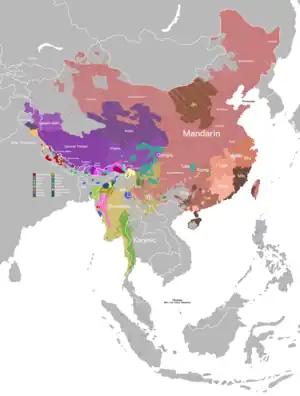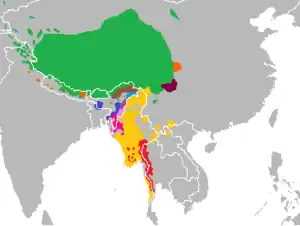

Meitei language, also known as Manipuri language, is classified as either a Sino-Tibetan language or a language isolate or even an Indo-European language by different scholars and institutions.
As a Sino-Tibetan language
Regarding the position of Meitei language, in a publication of The Asiatic Society, authored by Suniti Kumar Chatterjee, a renowned Indian linguist, it is said as follows:[1]
"Among the various Tibeto-Burman languages, the most important, and in literature certainly of much greater importance than Newari, is the Meithei or Manipuri language."
According to the Encyclopedia Britannica, Meitei language belongs to the Kamarupan group of the Tibeto-Burman branch of the Sino-Tibetan languages.[3] Its classification is explained as follows:
"Manipur state and its surround are the locus from which the Tibeto-Burman family spread and diversified, making the genetic assignment of the region's languages very difficult. During the 19th and 20th centuries, different linguists conjectured that Manipuri belonged to one of several TB subdivisions. In the early 21st century the consensus view placed Manipuri in its own subdivision of the so-called Kamarupan group—a geographic rather than a genetic designation but one that must suffice until more definitive information becomes available."[4]
According to the Ethnologue, Meitei language is considered to be a member of the Sino-Tibetan languages, without the mentioning of any further classifications.[5]
According to the Glottolog, Meitei language is a member of the Kuki-Chin-Naga branch of the Sino-Tibetan languages.[6]
According to a publication of the Indian Institute of Advanced Study (IIAS), the classification of Meitei language is described as follows:[7]
"Matisoft (1991,2003) categorized Manipuri in the geographically determined group Kamarupan which traditionally covers for Kuki-Chin-Naga, Abor-Miri-Dafla and Bodo-Garo while the early classifier Grierson (1903-1924) put it in Kuki-Chin. By Vegelin and Voegelin (1965) it is in Kuki-ChinNaga, by Benedict (1972) in Kuki-Naga, Shafer (1874) recognizes as a separate branch under the Kukish section of Burmise division. The latest opinion is of Burling (2003, p. 187-188) though none has put Manipuri in Nage or Kuki group it will be better to keep Manipuri by itself."[8]
As a language isolate
Anglo-Indian scholars like Irengbam Mohendra opined that Meitei language is definitely not a member of Tibeto-Burman languages and there is more possibility of Meitei being a language isolate.[9][10]
Irengbam Mohendra strongly rejected George Abraham Grierson's classification of Meitei language as Tibeto-Burman, in which he highlighted the following:[11]
"Without fluffing my lines because of lack of space I will let three super-specialists play their part.
Three of the world's leading authorities on Tibeto-Burman language – James A Matisoff, Professor Emeritus, University of California (2003), George Van Driem, a Dutch linguist at Leiden University (2001) and David Bradley, Prof. at La Trobe University, Australia (1997) have independently re-classified Tibeto-Burman languages in which Meithei, now Meitei, is not included anymore. They have left Meitei lon as unclassified."— Irengbam Mohendra[12]
Mohendra also emphasized the fact that Grierson never came to Manipur or any nearby areas but was doing his own research by sitting within an office in Calcutta.[13]
In 1998, American linguist Robbins Burling of the University of Michigan, who had done considerable research on Northeast Indian languages, classified Meitei language as "an independent member of the Eastern Area of language group." Indian-American Sino-Tibetan linguist Shobhana Chelliah of the University of North Texas, is also of the opinion that Meitei language should be "unclassified" into any language group though it has some similarities with Tibeto-Burman languages. Irengbam Mohendra have the similar opinion.[14]
As an Indo-European language
In a publication of the "International Journal of Multidisciplinary Research and Modern Education" (IJMRME), Meitei language is classified as a member of the Indo-Aryan languages, a subdivision of the Indo-European language family.[15]
Some scholars like Atombapu Vidyaratna, Lairenmayum Ibungohal Singh and Dwijamani Deva Sharma, rejected the classification of Meitei language as Tibeto-Burman. Rajkumar Jhalajit Singh was among those who strongly supported the classification of Meitei language as an Indo-European member.[16]
See also
Notes
References
- ↑ Chatterji, Suniti Kumar (1951). KIRATA-JANA-KRTI THE INDO-MONGOLOIDS THEIR CONTRIBUTION TO THE HISTORY AND CULTURE OF INDIA (April 1998 ed.). Calcutta: The Asiatic Society; Digital Library of India; Internet Archive. pp. 157 (in original book), 187 (in digital book).
- ↑ Chatterji, Suniti Kumar (1951). KIRATA-JANA-KRTI THE INDO-MONGOLOIDS THEIR CONTRIBUTION TO THE HISTORY AND CULTURE OF INDIA (April 1998 ed.). Calcutta: The Asiatic Society; Digital Library of India; Internet Archive. pp. 157 (in original book), 187 (in digital book).
- ↑ "Manipuri language | Manipuri language | Meitei, India, Tibeto-Burman | Britannica". www.britannica.com. Retrieved 18 November 2023.
- ↑ "Manipuri language | Manipuri language | Meitei, India, Tibeto-Burman | Britannica". www.britannica.com. Retrieved 18 November 2023.
- ↑ "Meitei | Ethnologue Free". Ethnologue (Free All). Retrieved 18 November 2023.
- ↑ "Glottolog 4.8 - Manipuri". glottolog.org. Retrieved 18 November 2023.
- ↑ "A History of Manipuri Language – Indian Institute of Advanced Study". iias.ac.in. Indian Institute of Advanced Study (IIAS), Ministry of Education (MoE), Government of India. Retrieved 18 November 2023.
- ↑ "A History of Manipuri Language – Indian Institute of Advanced Study". iias.ac.in. Indian Institute of Advanced Study (IIAS), Ministry of Education (MoE), Government of India. Retrieved 18 November 2023.
- ↑ "Meiteis Meiteilon never been Tibeto Burman By Irengbam Mohendra". e-pao.net. UK. 2017 [12 August 2017]. Retrieved 18 November 2023.
- ↑ "The long-awaited genetic recognition that Meiteis & Meiteilon are not Tibeto-Burman". e-pao.net. UK. 2019 [20 June 2019]. Retrieved 18 November 2023.
- ↑ Singh, Dr Irengbam Mohendra (22 March 2011). "Who said the Meitei lon is Tibeto-Burman? Dr GRIERSON, but he was wrong – KanglaOnline". Retrieved 18 November 2023.
- ↑ Singh, Dr Irengbam Mohendra (22 March 2011). "Who said the Meitei lon is Tibeto-Burman? Dr GRIERSON, but he was wrong – KanglaOnline". Retrieved 18 November 2023.
- ↑ Singh, Dr Irengbam Mohendra (22 March 2011). "Who said the Meitei lon is Tibeto-Burman? Dr GRIERSON, but he was wrong – KanglaOnline". Retrieved 18 November 2023.
- ↑ "The long-awaited genetic recognition that Meiteis & Meiteilon are not Tibeto-Burman". e-pao.net. UK. 2019 [20 June 2019]. Retrieved 18 November 2023.
- ↑ "ORIGIN AND DEVELOPMENT OF THE MEITEI LANGUAGE" (PDF). rdmodernresearch.org. International Journal of Multidisciplinary Research and Modern Education (IJMRME). 2016.
- ↑ "ORIGIN AND DEVELOPMENT OF THE MEITEI LANGUAGE" (PDF). rdmodernresearch.org. International Journal of Multidisciplinary Research and Modern Education (IJMRME). 2016.
Further reading
- 1911 Encyclopædia Britannica/Tibeto-Burman Languages
- "Ebooks : Problems in the Analysis of Manipuri Languages. Central Institute of Indian Languages". www.ciil-ebooks.net. Retrieved 18 November 2023.
- "The People - Manipur Science and Technology Council (MASTEC)". mastec.nic.in. National Informatics Centre, Government of India. Retrieved 18 November 2023.
- "A need to rethink Meitei in sub-section of Chin group in Myanmar census code 402". www.thesangaiexpress.com. The Sangai Express. Retrieved 18 November 2023.